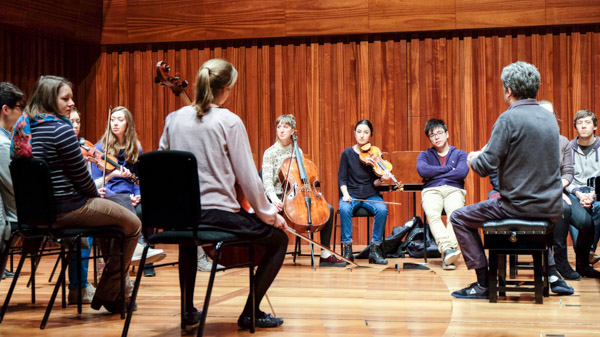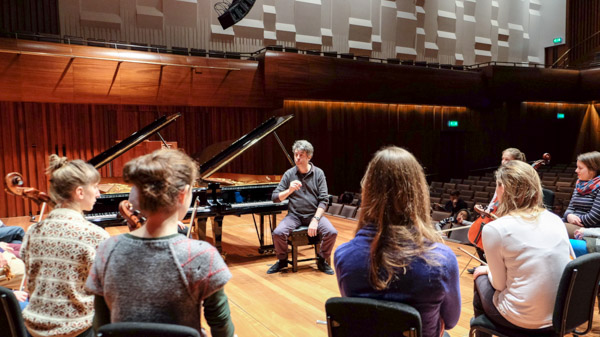Improvising with an ensemble
Workshop at the Milton Court concert hall with students of David Dolan.
A Workshop in London
On 27 February 2015 I gave a presentation and a workshop at the Reflective Conservatoire Conference in London about improvising with an ensemble of classical instrumentalists. The key topics and questions were: How to improvise in a tonal style? What are good strategies and working forms when teaching tonal improvisation to an ensemble? How can monodic instrumentalists work on harmony together? I have found that improvising on patterns or schemata as they were used in the 18th century is a very good starting point. But I wanted first and foremost to try out the idea’s behind Navigating through Harmony. For this there were two opportunities, a workshop for students of David Dolan, and a presentation in the program of the conference. For the presentation the Guildhall School of Music provided me with an ensemble of students, whom I only met shortly the day before. The materials presented all came into spontaneous existence at the moment and were never rehearsed. The ensemble consisted of three violinists (Katya, Danica and Sophie), two pianists (Sasha and Hélène), a flutist (Henri) and a cellist (Naomi). We had two grand piano’s on the stage. The presentation was held in the Milton Court Theatre, for quite a large audience.
Music is movement
We started the workshop by exploring a very basic principle of harmonic movement: where parallel triads disrupt the feeling of harmonic unity (each triad acts as a tonic), parallel sixth chords create a sense of movement. Compare I - II - III to I - VII6 - I6. In the teaching methods of Partimento (Gjerdingen, 2005) this principle is basically extended to include sixth chords on all degrees except I and V (rule of the octave). Working with an ensemble on harmony is particularly challenging and exciting because we don’t have it all in two hands like pianists do. The first exercise consisted of playing a solo on an elementary bass line: 8 - 7 - 6 - 5 - 3 - 4 - 5 - 1. In the next video all students play one by one an improvised solo part on the chords (unfortunately not all musicians are visible):
[VIDEO RCC1463 (14:38)] Ensemble playing on Bass Line
Two essential skills can be developed this way: awareness of how one moves inside the key area, and awareness of the intervals one plays on the bass notes. And I don’t mean here the theoretical ability to name the interval while one plays (now a minor third, now a major sixth…) but rather the ability to experience the level of consonance or dissonance in relationship to the bass note. To feel consciously if one plays octaves or fifths parallel with the bass, or thirds and sixths.
Next we played some patterns in a sequential way. The pattern was the bass line 3 - 4 - 5 - 1. Changing the 1 into the new 3 creates modulations along the circle of thirds. Understandably, the ensemble found this quite hard to do without any preparation. However, Sasha, one of the pianists picked the pattern up very quickly and a spontaneous duet followed through all 24 keys:
[VIDEO RCC1464A (00:43)] Sasha & Karst, Circle of Thirds
Navigating
After this nice warming up we continued to the materials of Navigating through Harmony. On the large beamer screen there was a projection of the simplified Weber grid (unfortunately not visible on the video). The students had never seen this before. I explained that in fact, most of the time in tonal improvisation the chords are pre-determined, such as in a jazz standard or baroque ground. The harmonic responsibility of the players is then quite limited. The real challenge would be to improvise together using tonality, but without a predetermined chord structure.
After a concise explanation of the Weber space and basics of the arrow language we make a first simple improvisation together. The movement is restricted to up and down. One of the students is the conductor, indicating the directions with the left hand while conducting the beat with the right. Henri is the conductor:
[VIDEO RCC1464B (09:24)] Henri conducting
The sooner the conductor shows the direction, the better the students can anticipate. This stimulates the aural imagination and trains to coördinate the action on the instrument to move towards a new chord. However, it’s not just the conductor telling the ensemble what to do, but the ensemble is also influencing the conductor by the notes they play, and the timing of those notes. For example one of the violins adding a minor seventh to the D major chord causes the conductor to indicate a down, without maybe even being conscious of it.
The next step is to be free to go multiple fifths up and down. Sasha is conducting in the following excerpt:
[VIDEO RCC1464C (12:03)] Sasha conducting
Expanding the number of fifths up and down creates more movement, but we also lose focus, especially since the ensemble plays major chords on each fundament. The effect of this was discussed shortly afterwards. Playing together in this way more often it can for example be decided to stay within one diatonic, and play notes within that single diatonic. Any other set of rules can be agreed upon, including to use certain rhythmical and motivic material.
Now the horizontal dimension is brought into play. I show how the left and down directions can work together to stay close to the tonic, and create a clear sense of tonality. As a result of me demonstrating these functional mode patterns on the piano the ensemble stays in the key of G, playing mainly with the degrees I, VI, II and V. In the following video excerpt Hélène is conducting, now also using the horizontal dimension:
[VIDEO RCC1464D (15:23)] Hélène conducting
Her gestures are clear and prepared well in advance, so the ensemble feels quite comfortable anticipating the harmonic changes. It is interesting to observe that one of the violinists plays a sixth (note E) in the final chord without feeling the need to go to a note of the tonic triad of G. This is probably caused by the frequent movements between I and VI, and their harmonic closeness. There is no doubt that G6 works well as a final chord, but the question is if the player is conscious of this fact. I believe it is important to discuss these matters in a classroom situation, however on a stage with an audience I did not interfere.
We discuss how the Fonte and Monte sequences from the Partimento tradition are similar to basic movements on the grid. Now we proceed with the full diatonic circle, starting with playing slowly through the circle of the key of a minor. I ask the students to specifically feel the harmonic movement as they go and be aware of the position of the tritone between VI and II. They all know this circle so well that they play improvised solo’s on it without any problem. It is ultimately the goal to get to know many of these patterns. With more experience and shifting the playing to come from inner hearing, the more the students will improve their direct control over the instrument, develop confidence, and become proficient in any key. An excerpt from the circle:
[VIDEO RCC1464E (20:05)] Improvising on the circle
Where the pianist is already a little more experienced, the two violinists are making a basic mistake by copying many of the bass notes. This is actually quite common when unexperienced with this way of playing together; the last violinist, while playing a very beautiful solo, unconsciously copies her melody notes from the bass notes (all except the G), creating in fact a line of parallel octaves. It is necessary to let students realize that this is what they are doing, so that they can develop a polyphonic hearing capability, consciously aiming for thirds, sixths, suspensions and other interesting notes, instead of doubling the bass.

